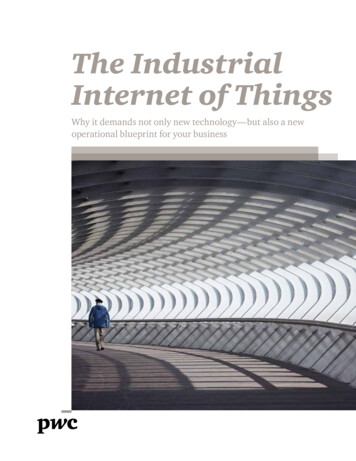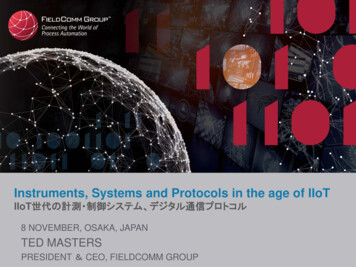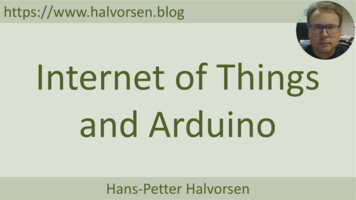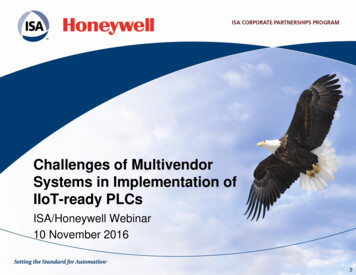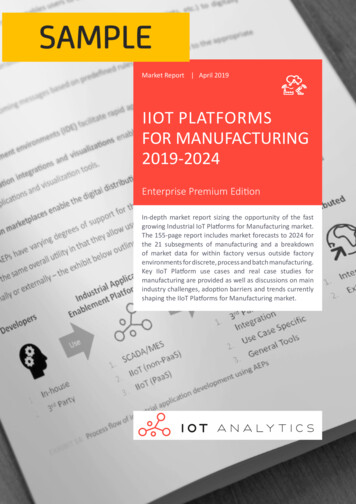
Transcription
Market Report April 2019IIOT PLATFORMSFOR MANUFACTURING2019-2024Enterprise Premium EditionIn-depth market report sizing the opportunity of the fastgrowing Industrial IoT Platforms for Manufacturing market.The 155-page report includes market forecasts to 2024 forthe 21 subsegments of manufacturing and a breakdownof market data for within factory versus outside factoryenvironments for discrete, process and batch manufacturing.Key IIoT Platform use cases and real case studies formanufacturing are provided as well as discussions on mainindustry challenges, adoption barriers and trends currentlyshaping the IIoT Platforms for Manufacturing market.
IIOT PLATFORMS FORMANUFACTURING 2019-2024Date: April 2019Author: Padraig Scully 2019 IoT Analytics. All rights reserved.ii
Table of ContentsExecutive Summaryvi1Introduction to IoT Platforms (general)11.1General role of IoT platforms in the IoT11.2Definition of IoT platforms51.3Industrial IoT Platforms for Manufacturing61.3.182Industrial IoT Platforms in the wider industrial software landscapeTechnical Overview of Industrial IoT Platforms92.192.22.3Technology segmentation2.1.1Telco connectivity platforms112.1.2Device management platforms142.1.3Cloud platforms (IaaS backends)172.1.4Application Enablement Platforms202.1.5Advanced analytics platforms24Hosting environment272.2.1On-premise (data center)272.2.2Private cloud (hosted)272.2.3Public cloud282.2.4Hybrid cloud302.2.5Multi cloud30Application deployment 32.3.3Self-contained systems352.4Security elements of the platform382.5Role of edge computing402.6Role of digital twins42 2019 IoT Analytics. All rights reserved.iii
2.7Role of Interoperability and Standardization462.8Role of Data Analytics & AI512.8.1Deep-dive: Gleaning Insights from Machine Sensor Data532.8.2Deep dive: Artificial Intelligence and Machine Learning542.8.3Deep dive: Analytics Architectures562.8.4Industry 4.0 Data Analytics & AI Trends59Role of Industrial App Stores and Distribution Methods602.93Market Analysis613.1Market characteristics overview613.2General IoT Platforms market (incl. non-manufacturing)623.2.1633.3IIoT Platforms for Manufacturing Market Overview3.3.164Manufacturing market by Type: Within factory environments versusOutside factory environments65Manufacturing market within factory environments by type:Discrete, process, batch663.3.3Manufacturing market within factory environments by subsegment673.3.4IIoT Platforms for Manufacturing market within factories by platform type723.3.5Market by region743.3.6Regional deep-dive: Asia753.3.7Regional deep-dive: Europe763.3.8Regional deep-dive: North America773.3.9Regional deep-dive: Other773.3.24General IoT Platforms market - All segmentsCustomer Needs, Use Cases and Case Studies784.1Customer Needs784.1.1Platform selection & evaluation794.1.2Choosing a lead vendor and understanding their partnership ecosystem834.1.3Most important customer needs854.2End user case studies4.2.187Case Study: Auto manufacturer saves 40M in downtime by sendingdata to the cloud 2019 IoT Analytics. All rights reserved.87iv
4.354.2.2Case Study: Fero labs helps oil refinery increase revenue by 4M using PdM884.2.3Case Study: Stanley Black & Decker increases OEE by 24% and first passquality by 16%894.2.4Case Study: Kemppi improves product quality while reducing development timeby 50% using IIoT technology904.2.5Case Study: Heller differentiates product offering with machine-as-a-service91OEM case studies924.3.1Case Studies934.3.2Adoption Strategy Comparison: OEMs from Different Industries954.3.3Adoption Strategy Deep-Dive: Elevator OEMs964.3.4Smart Factory Deep-Dives964.3.5Other Smart Factories113Market trends and challenges1145.1Trend 1: Platforms act as an enabler to move applications and data to the Cloud1145.2Trend 2: SCADA, MES, and ERP Systems Are Converging - IoT Platforms arebecoming part of the holistic solution1215.3Trend 3: New Edge Devices Are Connecting Directly to the Cloud (IoT Platform)1235.4Trend 4: IoT Platforms could play a role in the future of sellingManufacturing as a Service1305.5Trend 5: Platforms are a key enabler for Equipment as a Service business models1325.6Trend 6: IoT Platforms help production setups become more flexible1325.7Trend 7: IoT Platforms help value chains become more integrated1335.8Challenges / adoption barriers133Appendix135A.Market definition, methodology and sizing135B.List of Exhibits138C.List of Tables142D.List of Acronyms:144E.Industry 4.0148About153 2019 IoT Analytics. All rights reserved.v
ExECuTIvE SuMMARyExecutive SummaryOVERALL HIGHLIGHTS IIoT platforms for manufacturing market reached 1.7B in 2018.IIoT platforms for manufacturing market is growing quickly at a CAGR of 39% and expected to attain a marketsize of 12.5B by 2024.TECHNOLOGY 5 Platform types: The IoT platform market can be broken down into 5 types of platform: cloud platforms,application enablement platforms, device management platforms, connectivity platforms, and advancedanalytics platforms. These 5 platforms are broken down into 20 sub-elements, in addition to the overarchingelements present in all industrial platforms e.g., IoT device SDKs and data acquisition.Hosting environment: Shift from on-premise to hybrid cloud hosting environments as customers seek morecontrol over both the private and public components rather than just using a prepackaged public cloud.Application deployment architecture: Early platforms were built as monolithic architectures but are beingdeconstructed into modular, function-specific, inter-dependent, interacting microservice based deploymentse.g., Siemens MindSphere has over 20 such microservices (as of Oct 2018).MARKET ANALYSIS The overall IoT platforms market (for all verticals, not only manufacturing) was just under XX in 20XX andis expected to grow at a CAGR of XX% to reach XX in 20XX.The Manufacturing segment for IoT platforms reached XX in 20XX (with circa XX% of that within Factorysettings and XX% outside of the Factory), making Manufacturing the largest IoT platform segment and it isforecast to remain the largest IoT segment in 20XX almost reaching XX.Within Factory environments the IIoT platforms for manufacturing market is estimated to grow from a XXmarket in 20XX to a XX market by 20XX.Outside of Factory environments the IIoT platforms for manufacturing market is forecast to grow from XX in20XX to become a XX market by 2024.In 20XX, within Factory environments Discrete manufacturing accounted for XX (circa XX% of the IIoTplatforms for manufacturing market within factories) and is expected to grow to just under XX by 20XX. 2019 IoT Analytics. All rights reserved.vi
ExECuTIvE SuMMARy Within Factory environments XX manufacturing accounted for XX (circa XX% of IIoT platforms for manufacturingmarket within factories) in 20XX and XXX was XX (circa XX% of the IIoT platforms for manufacturing marketwithin factories. By 20XX, XXX and XX are forecast to grow to XX and XX respectively.Within Factory environments XXX manufacturing makes up the largest manufacturing subsegments with XXXthe largest subsegment and the only subsegment forecast to surpass XX by 20XX, XXX is followed by XXXand XXX estimated to reach XX, XX, and XX by 20XX respectively.CUSTOMER NEEDS, USE CASES & CASE STUDIES Customer perspective: Customers use a wide range of dimensions for IoT platform selection however valuefor xxx are typically top of mind.Customer needs: xxx perceived as the most important platform features for customers.xxx and xxx are the biggest use cases for IIoT platforms in Manufacturing: An increasing number of OEMs aredeploying IIoT platform solutions for to xxx.xxx and xxx are also leading IIoT platform use cases: Companies across a variety of industries (such as xxx)are partnering with xxx to xxx.IoT Adoption more likely from xxx: xxx and industries with xxx are more likely to adopt IoT products andstrategies.xxx are implementing best in class IoT solutions: xxx are leading the way in IoT adoption, with companies xxximplementing best in class solutions.DISRUPTIVE TRENDS & CHALLENGES TREND 1: xxxTREND 2: xxx.TREND 3: xxx.TREND 4: xxx.TREND 5: xxx.TREND 6: xxx.TREND 7: xxx. 2019 IoT Analytics. All rights reserved.vii
INTRODuCTION TO IOT PLATfORMS (GENERAL)1 Introduction to IoT Platforms (general)The Internet of Things is an increasingly important technology element for companies of nearly all sectorsand around the world. for many firms it has become one of the pillars of their “digitalization strategy”,promising the enablement of new business cases such as predictive maintenance, fleet management,infrastructure monitoring or analytics-based process optimization. One of the biggest driving forces rightnow is that connected IoT technology is being increasingly built into everyday products. Everything frombicycles, clothing to standard household appliances are being fitted with sensors and connected to theinternet enabling new value creation opportunities. In addition, cars, buildings, machines, and even entirecities are becoming part of a network-enabled ecosystem of things. As part of these connected solutions fewcompanies today build the whole solution themselves from scratch. Rather, IoT (software) platforms haveemerged as a crucial enabling element. for companies deploying connected solutions (or building connectedoperations), choosing a platform that is easy-to-use, comes with the right features and provides end-2-endsecurity has become a topic of major strategic importance.IoT Building blocksSecurityApplicationsIoT PlatformsSoftware backendCommunicationHardwareEXHIbIT 1: Central building blocks of IoT - IoT platforms are part of the central software backend in the IoT infrastructure. Source: IoT Analytics.Copyright 2018 by www.iot-analytics.com All rights reservedIoT platforms play a central role in the IoT architecture1.1 General role of IoT platforms in the IoTSource: IoT Analytics – June 2018 2019 IoT Analytics. All rights reserved.1
INTRODuCTION TO IOT PLATfORMS (GENERAL)There are four major technological building blocks of IoT. To understand the role of IoT platforms in theInternet of Things, it is important to relate to the IoT technology stack. On a high level, four major technologicalbuilding blocks of IoT exist; hardware, communication, software backend, and applications. Security is anadditional element that is so important it needs to be mentioned as a foundation for each of the four blocks.1.Hardware: Every IoT solution has a device layer where physical hardware hosts sensors, microchips, andconnectivity modules and in some cases has optional capabilities for storage, manageability, analyticsand security. In most cases the physical device itself, whether powered by battery or plugged in to themains, produces data and on a high level can be classified as a simple or smart device: Simple Devices: A simple device is an electronic device connected to a network (or other devices),typically via wireless protocols (e.g., Wifi, MQTT, etc.), that can be to some extent controlledremotely to perform instant actions and transmit generated data. Typically, simple devices haveconstrained resources, low hardware costs, basic connectivity, basic security/identity, and no/lightmanageability. A typical example of a device classified as a simple device is a connected lightbulbwith a microcontroller (MCu). Smart Devices: A smart device refers to a network-enabled electronic device with added capabilitiesfor local compute, storage, edge analytics and time-sensitive decision making for the generated data.There are different levels of “smartness” in devices that typically maximize security, manageability,interoperability for increased solutions reliability and reduced bandwidth costs. In many cases, cloudenabled smart devices are equipped with a microprocessor (MPu) and a natural user interface. Atypical example of a device classified as a smart device is a smart connected vending machine. IoT gateways: Other devices in IoT network architectures that can be classified as a smart deviceinclude hardware gateways or other edge processing devices such as PLCs. They are an importantelement in terms of edge and security configuration.2.Communication: The communication part of the technology infrastructure ensures the hardwareis connected (e.g., via proprietary or open-source communication protocols) to the network and thesoftware backend. Multiple communication protocols are required across 4 layers: 1. Network access and physical layer: IoT network technologies such as Bluetooth, Wifi, Ethernet,cellular, satellite and more specialized solutions like LPWAN, Bluetooth, ZigBee, and RfID. 2019 IoT Analytics. All rights reserved.2
INTRODuCTION TO IOT PLATfORMS (GENERAL) 2. Internet layer: IoT network technologies such as IPv6, 6LoWPAN, and RPL. 3. Transport layer: IoT network technologies such as uDP and TCP. 4. Application layer: IoT network technologies such as RESTful HTTP, HTTPS and messaging protocolslike MQTT, AMQP, CoAP and xMPP.Network operators offer both long range / low bandwidth networks (e.g., Sigfox, Weightless, LoRa, LTE-M,NB-IoT) and long range / high bandwidth networks (e.g., GSM, CDMA, LTE, WiMax, M2M, 5G) as well assatellite and fixed networks. In addition, there is a short range mix of networks available (e.g., BLE, Wifi,Z-wave, ZigBee, Thread).EXHIbIT 2: The technology architecture of the Internet of Things. Source: IoT Analytics.3.Software backend: IoT solutions require a middleware and software backend to ingest, store, manageand transform data to be used in applications. These tasks can be performed through self-programmedproprietary code, through the use of modular or open-source software elements and increasingly throughIoT Platforms that promise to bring most or all required elements out of the box, thereby reducing theneed to reinvent basic logic. Generally, these IoT platforms are deployed on a private cloud, public cloudor a hybrid of both. Standardized IoT platform offerings can typically be enhanced with additional customcode and add-on features which are often built on-top of middleware to enhance platform capabilities.See Chapter 2 for a more detailed technical specification of IoT platforms. 2019 IoT Analytics. All rights reserved.3
INTRODuCTION TO IOT PLATfORMS (GENERAL)4.Applications: Applications present the IoT use case to the end-user (B2C or B2B) enabling interactionwith the physical world. Typically, these applications combine data from real world IoT devices and othersources to give an overview or perform specific tasks. Apps bring the solution to life and can run ondevices/things or smartphones, tablets, PCs for human interaction.5.Security: IoT security happens on 4 different layers: device, communication, cloud, and lifecyclemanagement. These layers work in unison combining security solutions across the stack such as securitychips, message encryption, disk encryption, user authentication and access control. This multi-layeredsecurity approach seamlessly works together to provide complete end-to-end security from device tocloud and everything in between throughout the lifecycle of the solution.IoT platforms modularize and standardize IoT solution architecture: The technology architecture of IoTplatforms is currently far from being homogenized or accurately defined. In fact, the technology architectureis rapidly evolving with hundreds of different hardware units, connection protocols, low-level softwarelanguages, and an increasing number of applications requiring interoperability throughout the IoT ecosystem.IoT platforms aim to address this diversity with a modular and standardized approach. However, it remains arelatively young infrastructure that has yet to come of age.Today, IoT platforms are recognized as a crucial element linking the physical to the digital world. With apotential billion-dollar market up for grabs, many companies are now offering IoT platforms (or elementsthereof) and are striving to become the dominant platform for the IoT. Much like other new technologiesthat formed in the last 30 years, platforms that secure an early advantage may dominate the market later ondue to network effects. (e.g., consider how Apple’s iOS platform gained early domination of the smartphonemarket that earned the company an extremely lucrative and influential minority position against Android ina market that is a quasi-duopoly today.) 2019 IoT Analytics. All rights reserved.4
INTRODuCTION TO IOT PLATfORMS (GENERAL)1.2 Definition of IoT platformsIoT Platforms are a piece of modular software technology that enable solutions for IoT device connectivity,device management, data management in the cloud, application development and enablement, advancedanalytics, and even cybersecurity solutions for connected IoT devices. for this report, IoT platforms canbe dissected into 5 parts: 1. Connectivity platforms, 2. Device Management platforms, 3. Cloud backendplatforms, 4. Application Enablement platforms, and 5. Advanced analytics platforms. Note: The focus of thisreport is on Device Management, Cloud Backend, and Application Enablement platforms.1.Telco connectivity platforms: are a form of Platform-as-a-Service that offer coverage capabilities andsolutions for connecting the IoT device, managing and orchestrating connectivity, and provisioningcommunication services for connected IoT devices typically outside factory environments.2.Device management platforms: are a form of Platform-as-a-Service (or device cloud) that handleprovisioning tasks to ensure connected devices are deployed, configured, and kept up-to-date withregular firmware/software updates.3.Cloud platforms (IaaS backends): are a form of Infrastructure-as-a-Service that offer a scalable enterprisegrade backend for data management of IoT applications and services.4.Application Enablement Platforms (AEPs): are a form of Platform-as-a-Service that also offer Softwareas-a-Service solutions enabling developers rapidly create, test, and deploy an IoT application or service.5.Advanced analytics platforms: are a form of Platform-as-a-Service that also offer Software-as-a-Servicesolutions for sophisticated analytics tools including machine learning techniques and streaming analyticscapabilities to extract actionable insights from IoT data.Other IoT platforms Security platforms: are a form of Platform-as-a-Service that offer advanced cybersecurity solutionsacross the stack from device, secure communication, secure IoT cloud to secure lifecycle management.Security platforms are beyond the scope of this report, for more research on security platforms check outour dedicated market report IoT security report or our list of 150 security platforms. See Chapter 2.1 Technology segmentation for a more detailed breakdown of IoT platforms and their maincomponents. 2019 IoT Analytics. All rights reserved.5
INTRODuCTION TO IOT PLATfORMS (GENERAL)1.3 Industrial IoT Platforms for ManufacturingIndustrial IoT Platforms are tailor made for connecting assets/equipment in industrial settings - such settingsare commonly referred to as Industry 4.0 or Industrial IoT environments.IIoT is the industrial subset of theInternet of Things (IoT). At a high level, IoT is about adopting the internet in almost all economic activities, andit focuses on the technology backend for cross category connectivity and interoperability. The emergenceand swift development of the IoT is driven by the six major technological developments shown in Exhibit 3:EXHIbIT 3: Emergence of the Internet of Things. Source: STM Microelectronics, McKinsey, yole Développement, IoT Analytics.1.Increased adoption of mobile devices2.Declining costs for hardware such as sensors (Through the economies of scale potential from e.g.smartphone production and operation)3.Declining costs of bandwidth4.Declining costs of data handling, such as processing ( /MIPS) and data storage ( /GB) 2019 IoT Analytics. All rights reserved.6
INTRODuCTION TO IOT PLATfORMS (GENERAL)5.Decreased size of hardware elements6.Increased maturity of big data tools and infrastructureNote: MIPS Million instructions per secondThe Industrial IoT (IIoT) refers to heavy industries such as manufacturing, energy, oil and gas, and agriculturein which industrial assets are connected to the internet. Within IoT, different segments are more “industrial”than others, and “Connected Industry”, which specifically focuses on manufacturing, is on the most industrialend of the spectrum as shown in Exhibit 4. This report takes a deep dive into Manufacturing to specificallyexplore the impact of Industrial IoT Platforms in the sector. for more info on Industry 4.0 see Appendix E.Internet of Things (IoT)I4.0MaincategoryIndustries/ApplicationsRetail Digital signage In-store offering& promotions Supply chain Smart ordering& payment VendingmachinesHealthcare Adherence &support Clinical Virtual care Wellness &preventionInsurance Health and lifeinsurance Home insurance Industrialinsurance Vehicleinsurance CrossConnectedCarBuildings& LivingSmart Cities& Energy Assisted &autonomousdriving Fleetmanagement In-vehicleinfotainment Shared mobility Smartnavigation Vehicleassistance Energy efficiency& HVAC Homeequipment &appliances Living assistance Safety & security Vehicle-toinfrastructuresolutions Workplaceoperations Construction Education Energy Environmental Roads, traffic &transport Social & Security Water & WasteLess IndustrialNaturalresources Agriculture Mining Oil & gasConnectedIndustry Connected field Digital factory Product design& engineering Smartmaintenance Supply chainmanagementMore IndustrialEXHIbIT 4: IoT categories sorted from least to most industrial. Source: IoT Analytics 2019 IoT Analytics. All rights reserved.7
INTRODuCTION TO IOT PLATfORMS (GENERAL)1.3.1 Industrial IoT Platforms in the wider industrial software landscapeEXHIbIT 5: Industrial IoT platforms are adjacent to typical industrial software solutions, but also replacing some of them.IIoT platforms are starting to replace existing industrial software solutions. Typical industrial softwaresolutions include a mix of both IT and OT solutions. IT solutions include common business oversightapplications and reporting tools as well as common Enterprise solutions for ERP, PLM, CAD, CAM and SCM.OT solutions include common machine controllers (e.g. PLCs, CNCs, etc) and SCADA/DCS systems for controland data acquistion from machines and the factory floor. Operations management toos such as MES forproduction, maintenance, quality, inventory, etc can be classified as a mix of IT and OT technologies. IndustrialIoT Platforms are an adjacent technology to these typical industrial software solutions but are now starting toreplace some of them in smart connected factory settings - see chapter 4 for more details. 2019 IoT Analytics. All rights reserved.8
TECHNICAL OvERvIEW Of INDuSTRIAL IOT PLATfORMS2 Technical Overview of Industrial IoTPlatformsThis chapter provides an overview of the fundamental technological components of an IoT platform, thehosting environment and application deployment architecture options, and describes the role of edgecomputing and digital twins before introducing interoperability, standardization, security and other elementsof an IoT platform. understanding these components and concepts is vital to fully comprehend the differencesbetween IoT platforms on the market.Technology segmentation2.1 ofTechnologysegmentationTypesIoT platformsand their elementsPlatform typeAd anced analyticsplatformApplication enablementPaaSIaaS cloud backende ice management PaaSTelco connecti ityplatformIndustrial dataconnectivity plat ormSource: IoT Analytics –lements componentstreaming analyticsAI achine learningigital twinsules engine event managementIntegrated development environmentusiness app integration visuali ationIoT application mar etplaceIoT hubscalable storageulti-modal database supportata processingeployment con igurationevice monitoringCommand controlTA irmware updatesdge application li ecycleConnectivity orchestrationConnectivity managementervice provisioningilling managementIoT evicesata ac uisition drivers inter acesarch 201EXHIbIT 6: The 5 types of IoT Platform and their elementsl. Source: IoT Analytics. 2019 IoT Analytics. All rights reserved.9
MARKET ANALySIS3 Market AnalysisThis chapter presents analysis of the IIoT platforms for manufacturing market including a total market forecastto 2024. The analysis first breaks down the overall IIoT platforms for manufacturing market into two distincttypes: within factory environments and outside factory environments. Within factory environments are thenfurther broken down into 3 main types of manufacturing: discrete, process and batch. Market numbers forIIoT platforms for manufacturing are provided for 21 industry subsegments.Market sizing by region is provided with three regional deep-dives as well as a market split by technology(platform type and deployment type).3.1 Market characteristics overviewThe IIoT platforms for manufacturing market remains fragmented with many players competing for marketshare. Signs of consolidation are only slowly appearing with a number of acquisitions and mergers in recentyears e.g., relayr was acquired by Munich Re in 2018 and Cumulocity was acquired by Software AG in 2017.The fact that this market was more or less non-existent a decade ago means most platforms are only afew years old and the nascent market is currently full of early phase IIoT projects. IoT Analytics’ researchshows proof of concepts, pilot projects and small-medium scale deployments account for 83% of identifiedenterprise IIoT projects. Nevertheless, some platforms are now becoming more mature and supporting largerroll-outs such as Microsoft and AWS. 2019 IoT Analytics. All rights reserved.61
MARKET ANALySISIIoTP foranufacturing3.3ast IIoTPlatformsfor o reachB byCAGR%02018201920202021202220232024Copyright 2018 by www.iot-analytics.com All rights reservedGlobal IIoT Platforms for Manufacturing Market Size (in M)Note: The IIoT Platforms for Manufacturing market accounts for both Factory & Non-factory settings; that is standardized production environments such as factories, plants, workshops, as well ascustom production worksites such as mines, offshore oil&gas and construction sites.Source: IoT Analytics – March 2019EXHIbIT 18: Global IIoT Platforms for Manufacturing Market Size (in M) 2018-2024. Source: Iot Analytics - March 2019 2019 IoT Analytics. All rights reserved.64
MARKET ANALySIS3.3.1 Manufacturing market by Type: Within factory environments versus Outside factoryIIoTPenvironmentsfor anufacturingithin factory settings account for o erofanufacturingGlobal IIoT Platforms for Manufacturing Market (in M) - By type Within factories v Outside factories201 220232024Copyright 2018 by www.iot-analytics.com All rights reservedWithin factoriesNote: The Manufacturing segment of the IoT platforms market accounts for both Factory & Non-factory settings; that is standardized production environments such as factories, plants, workshops,as well as custom production worksites such as mines, offshore oil&gas and construction sites.Source: IoT Analytics – March 2019EXHIbIT 19: Global IIoT Platforms for Manufacturing Market (in M) 2018-2024 by type within v outside factory environments. (Source: IoTAnalytics - March 2019) 2019 IoT Analytics. All rights reserved.65
MARKET ANALySIS3.3.2IIoTPManufacturingmarket Within factory environments by Type: Discrete, process,for anufacturingbatchiscreteanufacturing dominants IIoTP use in actory settings201 24Global IIoT Platforms for Manufacturing Market Size (in M) - Within factories by t 2018 by www.iot-analytics.com All rights reservedXXNote: The global market size of IIoT Platforms for Manufacturing inlcudes Factory settings such as standardized production environments, factories, plants, workshops and can be broken down intorepresentative types of iscrete, Process, and atch Manufacturing.Source: IoT Analytics – March 2019EXHIbIT 20: Global IIoT Platforms for Manufacturing Market Size (in M) 2018-2024 within factories by type. Source: IoT Analytics. 2019 IoT Analytics. All rights reserved.66
MARKET ANALySISarket by subsegment3.3.3 Manufacturing market Within factory environments by Subsegmentanufacturing of Transportationuipment the biggest segmentXXXXXXXXXXXXXXXXXXXXXXXXXXGlobal IIoT Platforms for Manufacturing Market Size (in M) - By yright 2018 by www.iot-analytics.com All rights reserved201 242024Note: The Manufacturing segment can be broken down into 21 subsegments.Source: IoT Analytics – arch 201EXHIbIT 21: Global IIoT Platforms for Manufacturing Market Size (in M) 2018-2024 within factories by subsegment. Source: IoT Analytics.The Within factory type of IIoT Platforms for manufacturing can be broken down into 21 subsegments. 2019 IoT Analytics. All rights reserved.67
mproving own operations”MARKET ANALySIS3.3.3.1 COMMONLY DEPLOYED USE CASESns”List of overall top use cases in Manufacturings orQuestion: Can you indicate for which Manufacturing use cases you have evaluated IIoT %* More than one answer possible, thenumbers therefore do not add up to 100%Source(s): IoT Analytics ResearchAverage # of usecases supportedby one platformxxOther: use Case x use Case x use Case x use Case x use Case xEXHIbIT 25: List of overall top use cases in Manufacturing 2019 IoT Analytics. All rights reserved.Slide 1970
MARKET ANALySISarket by platform typeCloud & AEP platforms dominant the IIoT platforms
5.4 Trend 4: IoT Pla orms could play a role in the future of selling Manufacturing as a Service 130 5.5 Trend 5: Pla orms are a key enabler for Equipment as a Service business models 132 5.6 Trend 6: IoT Pla orms help producon setups become more exible 132 5.7 Trend 7: IoT Pla orms help value chains become more integrated 133







